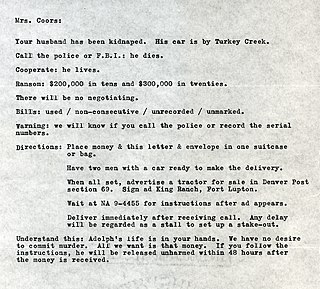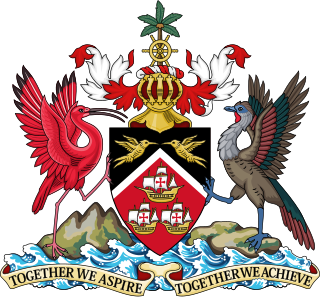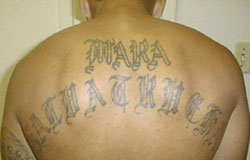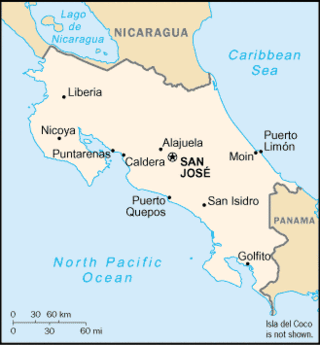Related Research Articles

Port of Spain, officially the City of Port of Spain, is the capital of Trinidad and Tobago and the third largest municipality, after Chaguanas and San Fernando. The city has a municipal population of 49,031, an urban population of 545,045 and a transient daily population of 250,000. It is located on the Gulf of Paria, on the northwest coast of the island of Trinidad and is part of a larger conurbation stretching from Chaguaramas in the west to Arima in the east with an estimated population of 600,000.

In criminal law, kidnapping is the unlawful abduction and confinement of a person against their will. Kidnapping is typically but not necessarily accomplished by use of force or fear; i.e., it also usually involves menace/assault or/and battery; but it is still kidnapping without those additional elements, or if a person is enticed to enter the vehicle or dwelling willingly.

The Jammat-al-Muslimeen is a radical extremist Islamist fundamentalist group in Trinidad and Tobago.

Crime is one of the most urgent concerns facing Mexico, as Mexican drug trafficking rings play a major role in the flow of cocaine, methamphetamine, fentanyl, heroin, and marijuana transiting between Latin America and the United States. Drug trafficking has led to corruption, which has had a deleterious effect on Mexico's Federal Representative Republic. Drug trafficking and organized crime have been a major source of violent crime. Drug cartels and gangs have also branched out to conduct alternative illegal activities for profit, including sex trafficking in Mexico. Some of the most increasingly violent states in Mexico in 2020 included Guanajuato, Zacatecas, Michoacán, Jalisco, and Querétaro. Some of the world's most violent cities are reportedly within the state of Guanajuato with extortion from criminal groups now being commonplace. The state of Zacatecas is said to be valuable to multiple organized crime groups for drug trafficking, specifically methamphetamine to the United States. As of 2021, Michoacán is experiencing increased instances of extortion and kidnapping due to a growing presence and escalation in the armed conflicts between CJNG and Cárteles Unidos on regions bordering the neighboring state of Jalisco. CJNG is also currently battling the Los Chapitos faction of the Sinaloa Cartel in the North Mexican region of Sonora.

Crime in Brazil involves an elevated incidence of violent and non-violent crimes. Brazil's homicide rate was 27.4 per 100,000 inhabitants, according to the United Nations Office on Drugs and Crime (UNODC). Brazil has the highest number of intentional homicides in the world, with 57,358 in 2018. In recent years, the homicide rate in Brazil has begun to decline. The homicide rate was 20.64 per 100,000 in 2020 with 43,879 killings, similar to 2019, but down from 30.67 per 100,000 in 2017.
Philadelphia consistently ranks above the national average in terms of crime, especially violent offenses. It has the highest violent crime rate of the Top 10 American cities with a population greater than 1 million residents as well as the highest poverty rate among these cities. It has been included in real estate analytics company NeighborhoodScout's "Top 100 Most Dangerous Cities in America" list every year since it has been compiled. Much of the crime is concentrated in the North, West, and Southwest sections of the city. The deadliest year in Philadelphia was 2021 with 562 murders.

Crime and violence affect the lives of millions of people in Latin America. Some consider social inequality to be a major contributing factor to levels of violence in Latin America, where the state fails to prevent crime and organized crime takes over State control in areas where the State is unable to assist the society such as in impoverished communities. In the years following the transitions from authoritarianism to democracy, crime and violence have become major problems in Latin America. The region experienced more than 2.5 million murders between 2000 and 2017. Several studies indicated the existence of an epidemic in the region; the Pan American Health Organization called violence in Latin America "the social pandemic of the 20th century." Apart from the direct human cost, the rise in crime and violence has imposed significant social costs and has made much more difficult the processes of economic and social development, democratic consolidation and regional integration in the Americas.
Crime in Atlanta, Georgia is above the national median and has been a major problem for the city since the middle 20th century.
Crime in Honduras has become a growing matter of concern for the Honduran population in recent years. Honduras has experienced alarmingly high levels of violence and criminal activity, with homicide rates reaching a peak in 2012, averaging 20 homicides per day. Corruption, extortion, coercion, and drug smuggling also run rampant throughout Honduran society, preventing the nation from building trustworthy authorities like police, and severely limiting economic, social, or political progress. The situation has prompted international organizations and governments to offer assistance in combating crime in Honduras.

Figures on crime in London are based primarily on two sets of statistics: the Crime Survey for England and Wales (CSEW) and police recorded crime data. Greater London is generally served by three police forces; the Metropolitan Police which is responsible for policing the vast majority of the capital, the City of London Police which is responsible for The Square Mile of the City of London and the British Transport Police, which polices the national rail network and the London Underground. A fourth police force in London, the Ministry of Defence Police, do not generally become involved with policing the general public. London also has a number of small constabularies for policing parks. Within the Home Office crime statistic publications, Greater London is referred to as the London Region.
Crime in Haiti is investigated by the Haitian police.
Crime in California refers to crime occurring within the U.S. state of California.
Crime rates in the state of Washington grew rapidly to large levels from 1960 to 1980, however slowed in growth from 1980 onward. Although the cause of this drop in crime growth from the 1980s cannot be directly determined, it was believed to have been a result from several law enforcement initiatives & policies implemented throughout the state of Washington and across the United States, such as abortion access.
Rates of crime in Guatemala are very high. An average of 101 murders per week were reported in 2018. The countries with the highest crime and violence rates in Central America are El Salvador and Honduras. In the 1990s Guatemala had four cities feature in Latin America's top ten cities by murder rate: Escuintla, Izabal (127), Santa Rosa Cuilapa (111) and Guatemala City (101). According to New Yorker magazine, in 2009, "fewer civilians were reported killed in the war zone of Iraq than were shot, stabbed, or beaten to death in Guatemala," and 97% of homicides "remain unsolved." Much of the violent nature of Guatemalan society stems back to a 36-year-long civil war However, not only has violence maintained its presence in the post-war context of the country following the Guatemalan Civil War, but it has extended to broader social and economic forms of violence.

Crime in El Salvador has been historically extremely high due to the presence of various gangs. As of 2011, there were an estimated 25,000 gang members at large in El Salvador; with another 43,500 in prison. The best-known gangs, called maras in colloquial Salvadoran Spanish, are Mara Salvatrucha (MS-13) and their rivals 18th Street; maras are hunted by death squads, including Sombra Negra. Newer rivals include the rising mara, The Rebels 13. El Salvador is one of the three countries of the Northern Triangle of Central America, along with neighboring Guatemala and Honduras, which are all afflicted with high levels of violence.
Colombia has a high crime rate due to being a center for the cultivation and trafficking of cocaine. The Colombian conflict began in the mid-1960s and is a low-intensity conflict between Colombian governments, paramilitary groups, crime syndicates, and left-wing guerrillas such as the Revolutionary Armed Forces of Colombia (FARC), and the National Liberation Army (ELN), fighting each other to increase their influence in Colombian territory. Two of the most important international actors that have contributed to the Colombian conflict are multinational companies and the United States.
Crime Watch is a Trinbagonian television program presented by host Ian Alleyne, to help profile and assist law enforcement in the apprehension of fugitives wanted for various crimes, including murder, rape, kidnapping, child molestation, white collar crime, organized crime, armed robbery and gang violence.
Crime in Venezuela is widespread, with violent crimes such as murder and kidnapping increasing for several years. In 2014, the United Nations attributed crime to the poor political and economic environment in the country—which, at the time, had the second highest murder rate in the world. Rates of crime rapidly began to increase during the presidency of Hugo Chávez due to the institutional instability of his Bolivarian government, underfunding of police resources, and severe inequality. Chávez's government sought a cultural hegemony by promoting class conflict and social fragmentation, which in turn encouraged "criminal gangs to kill, kidnap, rob and extort". Upon Chávez's death in 2013, Venezuela was ranked the most insecure nation in the world by Gallup.
Crime in Saint Kitts and Nevis is considerably higher than many other parts of the world. In 2012 Saint Kitts and Nevis had a homicide rate of 33.6 per 100,000 citizens, the 8th highest in the world, and the 7th highest during the period from 2005 to 2014. As of 2011 Basseterre had the highest murder rate of any capital city in the world at 131.6 per 100,000 inhabitants.

Costa Rica is a Central American nation that boasts of a noteworthy safety record on crime as compared to its neighbors in the region. It is one of few nations that have abolished their nation's armed forces. Having had a stable past, this country has been successful in developing its economy. However, since 2000 there has been a significant rise in criminal activity. Increase in domestic illegal activity, such as theft, homicide, and organised crime, has overwhelmed the local population. Sebastian Huhn reports that, "In a public opinion poll in 2011, 45 percent of Costa Rican respondents said that crime and insecurity were the country’s biggest social problems." As a consequence of the overall societal changes, domestic-driven crime has been increasing in the environment that extends beyond traditional settings. Illegal activity, including distribution of weapons has been most commonly witnessed during the sporting events by 'barras' or fan clubs. Crime in Costa Rica, thus, is not only due to domestic crime groups but also transnational criminal organisations.
References
- ↑ "Murder rate—40 killings a month | the Trinidad Guardian Newspaper". Archived from the original on 2018-05-02. Retrieved 2018-05-01.
- ↑ "Crime Statistics".
- ↑ "6 killed in 24 hours - Trinidad Guardian".
- ↑ "Trinidad and Tobago Police Service website". www.ttps.gov.tt. Retrieved 2010-06-26.
- ↑ "Maguire, Willis, Gantley, and Snipes (2008). "Spatial Concentrations of Violence in Trinidad and Tobago"".
- ↑ "Trinidad and Tobago Police Service website Press Releases". Ttps.gov.tt. Archived from the original on 2011-10-09. Retrieved 2010-06-26.
- ↑ "Kidnappings for ransom down". Ctntworld.com. May 13, 2011. Archived from the original on 2011-05-16. Retrieved 2010-06-26.
- ↑ "Police Tackle Kidnappings". NPR. 17 August 2007. Retrieved 2010-06-26.
- ↑ "We must get serious about combatting crime". Trinidad Express. June 24, 2011. Archived from the original on September 13, 2012. Retrieved 2010-06-26.
- ↑ "A Caribbean crime wave". The Economist. March 20, 2008. Retrieved 2010-06-26.
